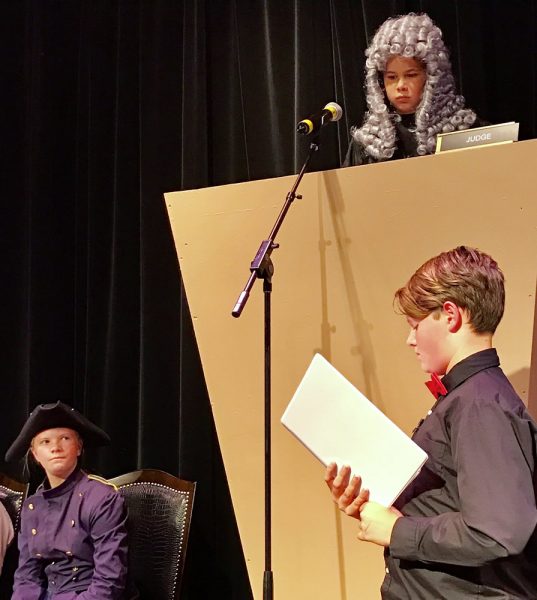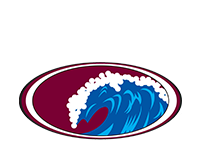By Amy Orr, Special to the Independent
“The jury has reached a verdict,” Judge Alden addressed the room from his perch high above the courtroom. The crowd fell silent and all eyes focused on the man with the gavel and the grey wig. The trial of Sir Francis Drake, accused of murdering the renowned pirate Blackbeard, was in its final moments.

Although Drake and Blackbeard were not actual contemporaries in history, other details of this fictional legal battle that played out in Laguna Beach last week were quite realistic, according to Noelle Martinez, an anthropology major and recent graduate of Baylor University. During questioning, witnesses analyzed bone fragments, evaluated wound patterns, inspected recovered weapons, and dissected time frames. The evidence presented was the culmination of a year of work by a well-trained forensics team. Of middle schoolers.
Three years ago, social studies teacher Michelle Martinez offered Thurston Middle School students an opportunity to dabble in forensics studies. With help from her daughter Noelle Martinez and teacher Kelly Skon, Mrs. Martinez led students in a mock trial of the accused axe murderer Lizzie Borden.
The 2014 program generated tremendous interest on campus. Mrs. Martinez now teaches 40 students in an after-school program and 25 students per semester in an elective class of forensic anthropology. Mrs. Martinez works with her daughter, starting a graduate program in forensic anthropology and archaeology at the University of Dundee in Scotland, and seventh-grade teacher Leah Prettyman. In a world where CSI is a television staple, youngsters are eager to learn about crime scenes and proper evidence-gathering techniques.
This year, students conducted an authentic crime scene investigation near tide pools in Dana Point. To set the scene, anthropologist Noelle Martinez “dipped the bodies in the ocean and dragged them up to the highest point of the tide.” Miss Martinez, a former president of the Baylor Forensic Society, used her training and experience to scatter artifacts in a realistic mock crime scene.
Wearing gloves and booties, Thurston investigators taped off the area and collected evidence under Miss Martinez’s direction. The school’s drone flew overhead, filming the process. The 360-degree footage was shown to jury members during the trial.
“Students love using and creating technology,” said Mrs. Martinez of tools obtained as a result of a Cox Communications grant. Mrs. Martinez said that her students used an iPad robot, an underwater robot, a 3D camera, virtual reality headsets, a 3D printer, and computers this year.
All of the jurors and select members of the audience were able to use VR headsets at the trial, thereby getting a first-hand view of the crime scene evidence collection. Mrs. Martinez wondered whether this access to the crime scene would “help or hinder the jury” in its decision.
This year, collaboration with the Ocean Institute in Dana Point allowed Thurston students to use marine technology. Students deployed an underwater robot in the Institute’s remotely operated vehicle test tank, said Jonathan Witt, senior education director at the Ocean Institute. Miss Martinez, who said she has helped in multiple underwater recoveries, swam in scuba gear to replicate authentic survey site retrieval.
Structuring a story around the forensic evidence, eighth-grader Sophia Lander and seventh- grader Keegan Thomas said they spent months of lunch hours consulting with Mrs. Martinez and writing the script for the mock trial. Sophia played the role of the prosecuting attorney and Keegan was the defending attorney.
Sophia, whose parents are both scientists, is fascinated by DNA’s impact on genetics. Intrigued by the scientific aspect of forensics, she said she really enjoyed her three years in Mrs. Martinez’s program. During the trial, Sophia argued “Drake had the means, motive, and opportunity to kill Blackbeard.”
Keegan sought to cast doubt on Drake’s guilt by providing other plausible murderers, such as Pennsylvania Governor Alexander Spotswood. He called multiple witnesses and passionately presented a case for the defendant.
At the play’s conclusion, jurors deliberated but were unable to reach a unanimous verdict. Keegan said that, given the evidence, the verdict could have gone either way.
“Sophia and I both had strong claims,” he admitted. “We wrote the script to show both sides.”
Mrs. Martinez says that a hung jury creates an opportunity for a retrial next year. In September, future investigators, scientists, and litigators will have another chance to use technology and examine forensic evidence as they work to unravel the truth.





[…] students worked so hard and I’m sure they’ll really appreciate the recognition from the article. I hope you found the trial as entertaining as I […]